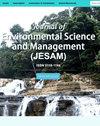木豆热解生产生物油的技术、经济和环境评价[j]Millsp。]木材
IF 0.3
4区 环境科学与生态学
Q4 ENVIRONMENTAL SCIENCES
引用次数: 1
摘要
豌豆。使用半连续克级反应器在温度(469°C)、氮气流速(14.2 mL min-1)和粒度(1.3 mm)的优化条件下热解木材,产生生物油(54%)、生物炭(26%)和合成气(16%)。1 t yr-1的生物油生产成本估计为681.00美元。财务分析显示,按12%的贴现率计算,净现值(NPV)为24322.00美元,内部收益率为343.85%,盈亏平衡数量为199L。敏感性分析表明,原材料价格上涨30%,产品价格下跌25%,导致NPV和内部收益率增加。将生物油产量降低到40%以下会产生负NPV,内部收益率为9%。如果利用生物油和生物炭作为替代生物能源,可以节省36万升燃料油和259吨煤炭。可以避免749吨二氧化碳当量的温室气体排放总量。因此,鸽子豌豆热解用于生物油生产提供了净正能量输出,并被证明是一项有利可图的投资,是一种环境友好的潜在生物能源,可以取代石油燃料。本文章由计算机程序翻译,如有差异,请以英文原文为准。
Technical, Financial and Environmental Assessment of Bio-oil Production from Pyrolysis of Pigeon Pea [Cajanus cajan (L.) Millsp.] Wood
Pigeon pea (Cajanus cajan (L.) Millsp. wood was pyrolyzed using a semi-continuous gram-scale reactor at optimized conditions of temperature (469°C), nitrogen flow rate (14.2 mL min-1), and particle size (1.3 mm), yielding bio-oil (54%), biochar (26%), and syngas (16%). The cost of bio-oil production for 1 t yr-1 was estimated to be US$ 681.00. Financial analysis revealed a net present value (NPV)of US$ 24,322.00 at 12% discount rate, an IRR of 343.85 %, with breakeven quantity of 199 L. Sensitivity analysis showed that an increased price of raw materials up to 30 %, and a decreased price of products down to 25 %, resulted to an increased NPV and IRR. Decreasing the bio-oil yield below 40 % gave a negative NPV with an IRR of 9%. If bio-oil and biochar were tapped as alternative bioenergy, 360,000 L of fuel oil and 259 t of coal could be saved. A total greenhouse gas emission of 749 t of CO2 equivalent can be avoided. Thus, pigeon pea pyrolysis for bio-oil production provided a net positive energy output and was proven to be profitable investment, and environment-friendly as potential bioenergy resource to replace petroleum-based fuels.
求助全文
通过发布文献求助,成功后即可免费获取论文全文。
去求助
来源期刊

Journal of Environmental Science and Management
ENVIRONMENTAL SCIENCES-
CiteScore
0.90
自引率
0.00%
发文量
10
审稿时长
2 months
期刊介绍:
The Journal of Environmental Science and Management (JESAM) is an international scientific journal produced semi-annually by the University of the Philippines Los Baños (UPLB).
JESAM gives particular premium to manuscript submissions that employ integrated methods resulting to analyses that provide new insights in environmental science, particularly in the areas of:
environmental planning and management;
protected areas development, planning, and management;
community-based resources management;
environmental chemistry and toxicology;
environmental restoration;
social theory and environment; and
environmental security and management.
 求助内容:
求助内容: 应助结果提醒方式:
应助结果提醒方式:


